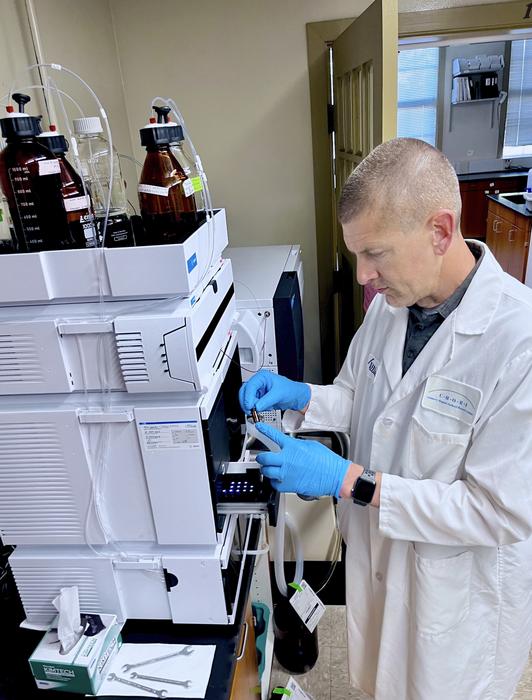Chicago (July 1, 2024) — What does whole wheat have that refined flour lacks? A new study reveals key differences in nutrient content along with exactly where nutrients are lost — and sometimes gained — along the journey from farm to table.

Credit: Holly Duden, UCSF
Chicago (July 1, 2024) — What does whole wheat have that refined flour lacks? A new study reveals key differences in nutrient content along with exactly where nutrients are lost — and sometimes gained — along the journey from farm to table.
While previous studies have assessed the nutrients contained in various crops or in food products, the new study is among the first to bridge the two by tracing how processing and baking influence nutrient composition at each step.
Researchers report that levels of major minerals were cut by nearly three-quarters in refined flour and breads made with refined flour compared with whole wheat. Additionally, milling and baking markedly reduced the amount of other nutrients, such as vitamin E, in both refined and whole wheat products compared with raw wheat kernels.
“Tracking nutrient content from farm to table is key for appraising what agricultural products actually contribute to the diet,” said David Killilea, PhD, a researcher at the University of California San Francisco. “Our experimental approach revealed that both milling and baking had significant impacts on multiple nutrient levels within wheat flour and bread.”
Killilea will present the findings at NUTRITION 2024, the flagship annual meeting of the American Society for Nutrition held June 29–July 2 in Chicago.
The Dietary Guidelines for Americans recommend that whole grains constitute at least half of the total grains we consume, but research shows that most people do not meet this recommendation. By revealing the stark differences in nutritional value between more refined and less refined wheat products, the study underscores the importance of a diet rich in whole grains.
“Whole grains have an important role to play in the nutritional palette of the Western diet, and we strongly support the promotion of whole grain consumption,” said Killilea. “Processes that enrich the nutrient density of wheat-based foods should be encouraged, while processes that deplete nutrient density should be understood.”
For the study, researchers obtained raw wheat kernels from a single farm source, milled the kernels to produce three different types of flour and then used the flours to prepare breads. They assessed the levels of major minerals (calcium, magnesium, phosphorous, potassium), trace minerals (copper, iron, molybdenum, zinc), carotenoids (vitamin A-like compounds) and vitamin E at each step.
The three flour types were intact whole wheat flour (produced by stone-milling), reconstituted whole wheat flour (produced by roller-milling) and refined white flour (produced by roller milling with bran and germ removed).
In the two types of whole wheat flours, levels of major minerals remained virtually unchanged from kernel to flour to bread, while the levels of some trace minerals actually increased during processing. In refined flours and breads, major minerals were reduced by up to 72% and trace minerals were reduced by up to 64% compared with wheat kernels.
Vitamin E levels dropped substantially with each processing step, regardless of the type of flour used to prepare the breads. Ultimately, breads made with all flour types contained less than one-fifth the amount of vitamin E as wheat kernels. Levels of carotenoids were also reduced when the flours were baked into breads, with all breads containing less than one-quarter the amount of carotenoids as wheat kernels.
Next, the researchers plan to study how different farming or processing practices could influence the nutrient density of wheat and wheat products. Since inadequacies of vitamins A and E are a significant health concern in the U.S., they plan to focus particularly on whether fermentation or other processes could help to preserve the vitamin content of wheat products.
Killilea will present this research at 2:12-2:24 p.m. CDT on Monday, July 1, during the Food Science and Nutrition session in McCormick Place (abstract; presentation details).
Please note that abstracts presented at NUTRITION 2024 were evaluated and selected by a committee of experts but have not generally undergone the same peer review process required for publication in a scientific journal. As such, the findings presented should be considered preliminary until a peer-reviewed publication is available.
About NUTRITION 2024
NUTRITION 2024 is the flagship meeting of the American Society for Nutrition and the premier educational event for nutritional professionals around the globe. NUTRITION brings together lab scientists, practicing clinicians, population health researchers, and community intervention investigators to identify solutions to today’s greatest nutrition challenges. Our audience also includes rising leaders in the field – undergraduate, graduate, and medical students. NUTRITION 2024 will be held June 29–July 2, 2024 in Chicago. #Nutrition2024
About the American Society for Nutrition (ASN)
ASN is the preeminent professional organization for nutrition research scientists and clinicians around the world. Founded in 1928, the society brings together the top nutrition researchers, medical practitioners, policy makers and industry leaders to advance our knowledge and application of nutrition. ASN publishes four peer-reviewed journals and provides education and professional development opportunities to advance nutrition research, practice, and education. Since 2018, the American Society of Nutrition has presented NUTRITION, the leading global annual meeting for nutrition professionals.
Find more news briefs from NUTRITION 2024 at:
###



